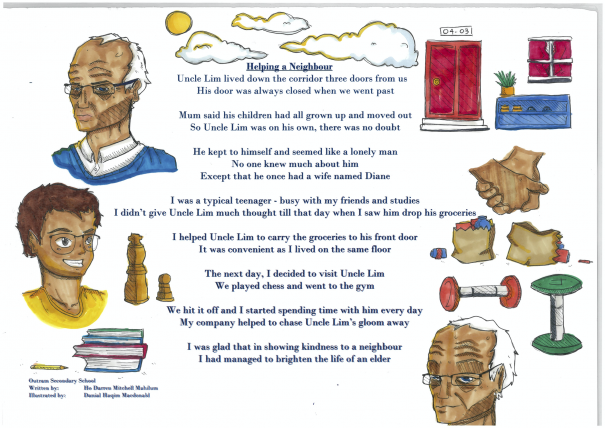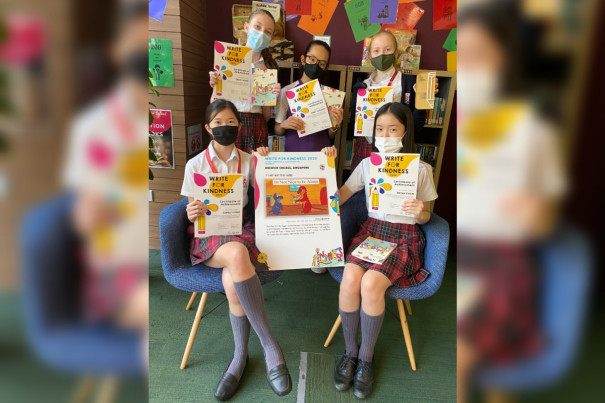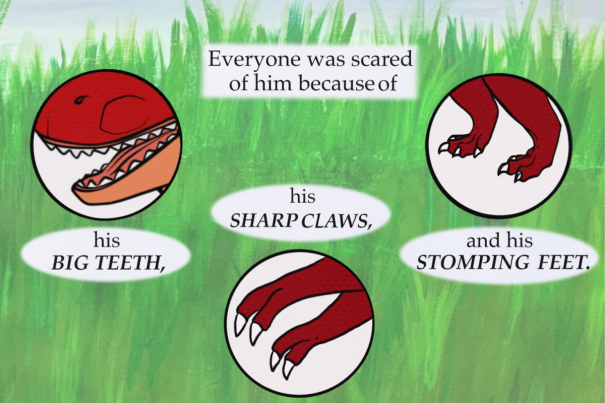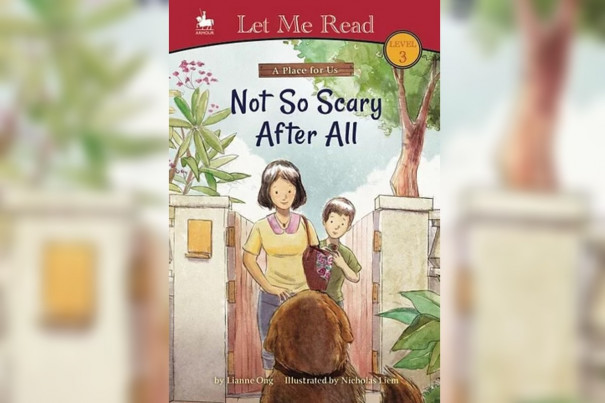For three years now, I’ve been running a picture book writing class for teenagers.
For the workshop, secondary schools and colleges send a team of students to go through a crash course with a local author, poet or artist to create an illustrated story or poem for pre-schoolers on a theme relating to kindness.
The class is part of the annual Write for Kindness competition run by the Singapore Kindness Movement, in partnership with the Singapore Book Council. Aside from cash prizes, winning teams have their book or poem published and distributed to all pre-schools in Singapore.
I half suspect that the students who come for the workshop are a little cynical about the prospect of writing about kindness, and joining a competition to boot.
Writing about a topic like kindness is associated with being ostentatiously virtuous, which can come across as not being genuine. And being a goody-two-shoes doesn’t have much cachet in your teen years.
It’s not that teenagers aren’t kind or that they don’t have any empathy for others. But it can be a bit more difficult to stay positive or affirmative when a significant proportion of your friends respond with a “wah so kind ah, sure or not?”
But therein lies the challenge of writing about such a topic. It is both simple and complex all at once.
Kindness isn’t about being preachy
When you write about a topic like kindness, you risk sounding preachy or cliched. But you don’t have to be. And that’s what I hope these students realise as they write their stories.
Take the two teams from Outram Secondary School for example. They came in first and second in the Poetry & Illustration Category last year.
They tell me that both teams brainstormed their ideas together, and agonised over not coming across as “cringey” and “basic”. Their nuanced and thoughtful poems about sharing the limelight with sports champions, and helping the elderly, however, were anything but.

The winning poem by Jude Michael Chua and Aryisha Muhd Reymie, titled Sharing The Limelight, is about how the winners in a sports competition chose to share their moment of glory with second prize winners, and by doing so, consoling them in their moment of disappointment:
“There was some joy in knowing we had passed the test
In the giving of our best
It was not a sweet ending to our dream
But we were consoled, we had lost to a better team”
It seems rather fitting (ironic, too) that the duo won the poetry category with their entry! The runners up, Darren Ho and Danial Haqim Macdonald, certainly gave their best too.
The two co-wrote Helping A Neighbour, which is about helping an elderly neighbour. They tell me that they worked hard in creating the persona of the elderly Mr Lim.
“Mum said his children had all grown up and moved out
So Uncle Lim was on his own, there was no doubtHe kept to himself and seemed like a lonely man
No one knew much about him
Except that he once had a wife named Diane”
Danial, who also illustrated the poem, and is a member of the school’s Visual Arts Club said: “As we went through many rounds of editing to keep to the word limit, I insisted that we kept the line ‘except that he once had a wife named Diane’ because I felt that really painted a picture of who Uncle Lim was.”

Writing for a younger audience
Another challenge the teams faced was realising that that writing for a pre-school audience can be tricky. They are, after all, writing for pre-school children a whole decade younger than they are.
In other words, they have to craft a meaningful story with very few words and simpler phrases.
In the picture book category, illustrations had to share in the task of storytelling as well.
Teenagers are schooled in writing compositions for tests and exams. So the exercise of writing a picture book for children comes almost as a shock to the system.
One common mistake is to dumb down an idea so much that its essence is lost, almost to the point of being patronising.
Don’t imagine that young children can’t perceive when something is oversimplified, I often warn my students. They might not be able to articulate it, but they will conclude that they didn’t enjoy reading the book. Children know.
So I find myself reminding them: Be childlike in your storytelling, not childish. Keep it simple, but don’t be simplistic. Tap on the wonder of childhood through the eyes of a child, not the cynical mindset of an adult.

The NJC team, comprised of members from The Writer’s Circle in NJC, won the first runner-up spot in the picture book category. The quintet of Pang Wan Leek, Soong Yuan Qi Sophie, Tan Pei Xuan, Thania Del Radovan Lofranco, Htat Wai Wai Aung created an illustrated book titled Something Sweeter Than Treats.
In it, a mouse who loves sweet treats discovers that being the recipient of a kind act is even better. He learns from Mr Lion – someone he least expects to be kind – that they can not only spread joy by being kind to others but by doing so, it also brings joy to themselves.
Team member Wan Leek said: “Planning the plot was hard as we needed to think about the message we wanted to send, especially to such a young demographic, as kindness is a broad topic.

“Eventually, we chose ‘Being kind is something that brings happiness not only to those you give it to but to yourself as well’. We thought it is a valuable and often untold lesson that children would want to learn.”
Writing a picture book for children, and dealing sensitively with a topic like kindness so that it doesn’t become pat and common, is not as easy as one would expect.
It is certainly not writing some formulaic composition that checks all the boxes.
It’s the process that matters
During my workshops, I can actually see how these teenagers start to truly embrace the spirit in which they are conducted – that they stop seeing kindness as a “thing” to do or a topic to write on, but really internalise it as a way of life.
It is through the rigour of thinking about what actually works for a children’s story that these students begin to sift through and distil their own ideas of kindness.

Dulwich College started participating in the Write for Kindness workshops in 2018.
Jane Hayes, the teacher librarian at Dulwich tells me that joining the competition has become an annual tradition now, and has kept the kindness conversation going in school.
This year, its team of Charlotte Johnson, Grace Cronin, Camille Cheng, Mana Yamazaki and Serena Kwon won top spot in the picture book category with It’s Not Nice To Be Alone, which is a story of the power of friendship: About a tyrannosaurus rex who gets ostracised by the other young dinosaurs on an island until a young triceratops gets to know the real him.

Jane says: “We are a relatively new international school here in Singapore, so we are more than a little chuffed by this recent success. We are very proud of the way our students are stepping up to the mark and supporting each other as they mature and develop their skills, understandings and knowledge.”
The very exercise of writing about kindness is a challenge in itself for a writer, but a valuable process. It becomes a journey of self-reflection and discovering where you stand on the topic.
Talking about kindness with children can start with stories

When I wrote A Place for Us, a children’s series about persons with special needs and intellectual disabilities, I became more conscious of my parenting. Was I unwittingly saying things to my children that would cause them to have unhealthy biases towards these persons who were neurotypically different? What could I do that would help them be open and empathetic to these persons?
Children’s books are a useful tool for parents to start difficult conversations with their children.
“I’ve totally enjoyed experiencing first-hand, through my five-year-old daughter, how books that touched on sensitive topics have helped prepare her for situations that may be hard for children to grapple with,” says Sylvia Seow, 34. She is the co-owner of local playdough business, Messy Fingers, and home-learning Instagram account @2mamas4kids.
“From moving into a new neighbourhood, entering a new school, caring for a classmate who’s wheelchair bound, to most recently, having to host a neighbour’s special-needs teen for an afternoon with no prior notice – I’m glad we’ve been reading widely to prepare her adequately for such situations.
“Through the works of children’s authors, I get to bring Allie on an imaginary rehearsal of how to respond with empathy and kindness, when she eventually meets people who might not respond in expected ways.”
Other stories you might like





The authors and illustrators in children’s Singlit know the privilege we have in bringing young children uplifting messages of hope. Through stories, we’re able to tell them that there are others just like them who feel the same way – happy, sad or angry. And we also tell them that there are others who are completely different: For example, through stories of special-needs children.
Knowing that we are sowing the seed of empathy in young readers, is something people in my profession do not take lightly. We also want to be able to give a voice to those who cannot speak for themselves and create awareness of what it’s like to be in their shoes.
The Write for Kindness entries are varied each year – some stand out, while others not so much, let’s be honest. But that’s okay. It’s an ongoing exercise for these students to engage with the topic in a creative, safe way and that’s what is important.
Writing picture books or poems about kindness should never get old so that we can keep the conversation about kindness going.
To register for the Write for Kindness workshops, please contact Ms Fairuz Atiqah at fai@kindness.sg.
If you like what you read, follow us on Twitter and Google News to get the latest updates.


